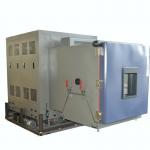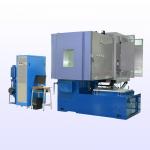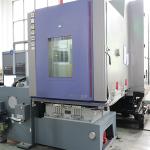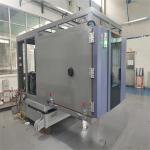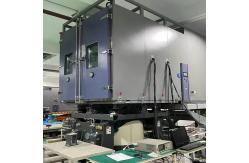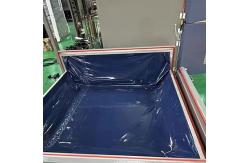In the automotive domain, the safety and comfort of passengers
hinge on the reliability and durability of every component within
the vehicle. The HALT HASS & AGREE Vibration Test Chambers,
meticulously crafted for NES M0131 High Temp testing of passenger
parts, emerge as a cornerstone in the pursuit of automotive
excellence. This state-of-the-art vibration test chamber is dedicated to
subjecting passenger parts to the exacting NES M0131 High Temp
testing protocol. It caters to automotive manufacturers, Tier 1
suppliers, and research institutions. The primary objective is to
evaluate the performance and integrity of passenger parts such as
seat components, dashboard elements, door trims, and interior
fittings under the combined duress of high temperatures and
vibration. By replicating the most extreme and realistic conditions
that these parts may face during a vehicle's operational lifespan,
manufacturers can unearth potential design flaws, optimize
materials and manufacturing processes, and ultimately enhance the
overall quality and safety of the automotive passenger experience. - Robust and Thermally Stable Chamber Construction
- The chamber is constructed with heavy-duty, heat-resistant
materials that can withstand the rigors of high-temperature and
vibration testing. The walls are fabricated from a combination of
high-strength steel and advanced thermal insulation layers,
ensuring minimal heat loss and a stable internal temperature
environment. The interior is designed to accommodate a diverse
range of passenger parts, with adjustable racks and fixtures that
guarantee proper positioning and uniform exposure to both heat and
vibration. The door is equipped with a precision sealing mechanism
and a heat-resistant viewing window, enabling operators to monitor
the testing process without compromising the integrity of the
chamber's internal conditions.
- Precision Temperature and Vibration Control Systems
- Temperature Control: Capable of achieving a wide temperature range
from ambient to +150°C with an accuracy of ±0.3°C. The system
employs state-of-the-art heating elements, along with a
sophisticated PID controller and multiple temperature sensors, to
maintain a precise and uniform temperature throughout the chamber.
This allows for the simulation of various high-temperature
scenarios that passenger parts may encounter, from the sweltering
heat of a parked vehicle in a sun-drenched parking lot to the
elevated temperatures near engine components.
- Vibration System: The chamber is outfitted with a high-performance
vibration platform that can generate a broad spectrum of vibration
frequencies and amplitudes. It can produce vibrations from 5 Hz to
2000 Hz with amplitudes up to 50 mm. The vibration system is
engineered to replicate the diverse vibration sources experienced
in a vehicle, including engine vibrations, road surface
irregularities, and the dynamic forces associated with vehicle
maneuvers. The vibration control system offers exceptional
precision, allowing for the programming of complex vibration
profiles and real-time adjustments to mimic different driving
conditions.
- Intuitive Control Panel and Data Acquisition Interface
- The control panel is designed with user-friendliness in mind,
providing operators with effortless access to all test parameters.
They can easily set and adjust temperature levels, vibration
frequencies, amplitudes, and test durations. The panel also
presents real-time information regarding the current temperature,
vibration status, and any alarms or warnings. The chamber is
integrated with a comprehensive data acquisition system that
records all pertinent test data. This encompasses temperature
histories, vibration waveforms, and any observable changes in the
physical or mechanical properties of the passenger parts. The data
can be stored in a built-in memory or exported to external storage
devices for in-depth analysis. The system is also capable of
generating detailed test reports in various formats.
- Safety Features and Alarms
- To ensure the safety of operators and the protection of the test
specimens and the chamber itself, a suite of safety features is
incorporated. These include over-temperature and over-vibration
protection systems, emergency stop buttons, and alarms for abnormal
temperature fluctuations, vibration malfunctions, or any other
equipment failures. The chamber is also equipped with proper
ventilation and exhaust systems to handle any potentially harmful
gases or vapors that may be emitted from the passenger parts during
high-temperature testing.
- Temperature Range and Accuracy
- The broad temperature range from ambient to +150°C with ±0.3°C
accuracy provides a comprehensive testing spectrum. This allows
manufacturers to assess the performance of passenger parts not only
under normal operating temperatures but also in extreme heat
scenarios. For example, components like plastic knobs or electronic
displays need to remain functional and aesthetically intact even
when exposed to temperatures well above typical ambient conditions.
The accurate temperature control ensures that the test conditions
are precisely maintained, providing reliable and repeatable
results.
- Vibration Parameters
- The vibration system's ability to produce frequencies from 5 Hz to
2000 Hz and amplitudes up to 50 mm allows for a thorough evaluation
of the passenger parts. Low-frequency vibrations can mimic the slow
oscillations caused by engine idling or driving on a bumpy road,
while high-frequency vibrations can replicate the rapid vibrations
associated with high-speed rotating components or electrical
switching. The precise control of vibration frequency and amplitude
is crucial for identifying potential resonance points and
weaknesses in the components.
|
